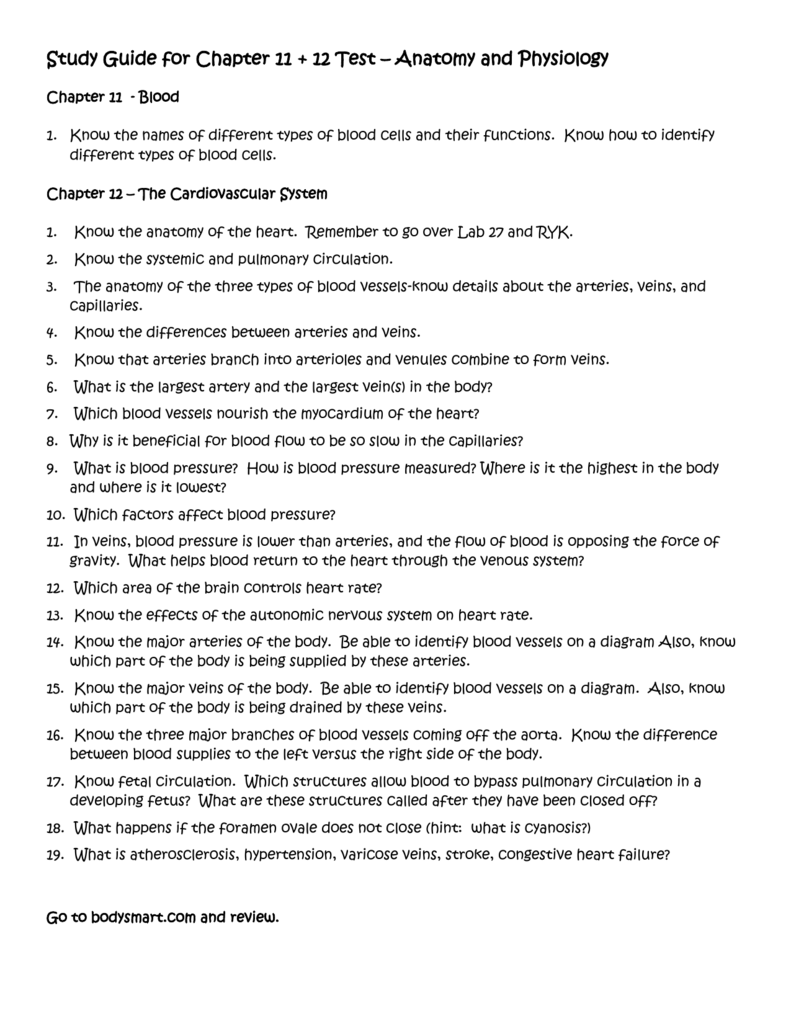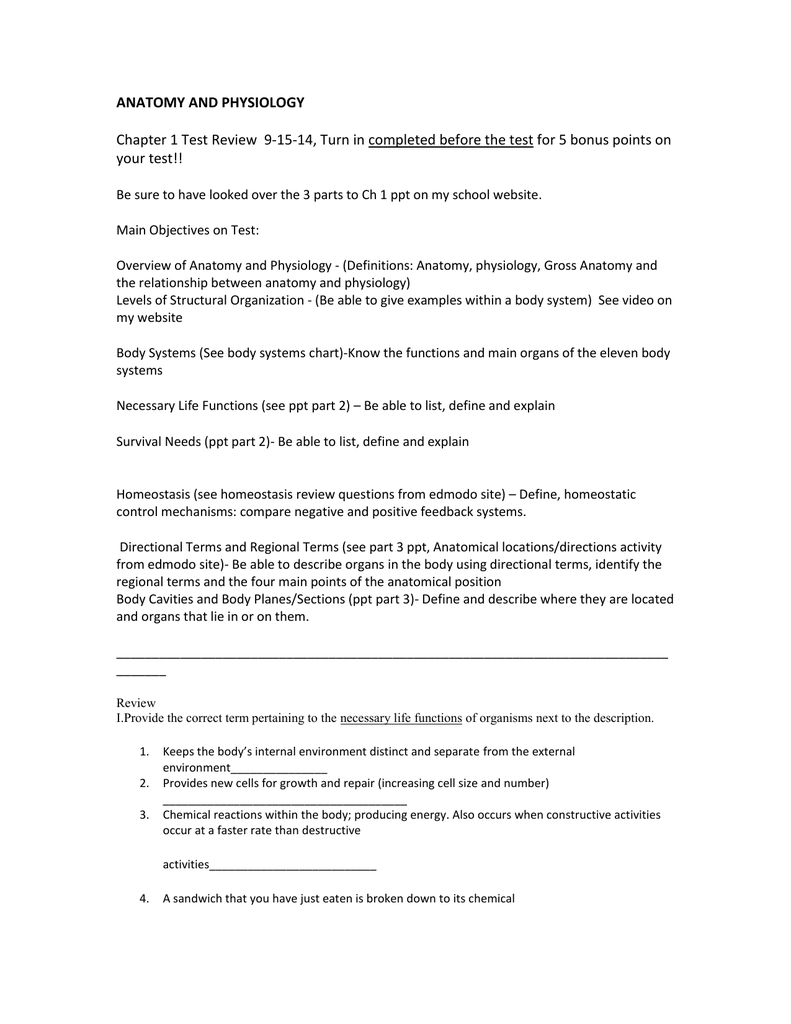Chapter 14 Practice Test Anatomy And Physiology
Chapter 14 Practice Test Anatomy And Physiology - Web 1.1 overview of anatomy and physiology; 1.3 functions of human life ; The immediate one is severe loss of body fluids, electrolytes, and proteins (from burned skin, leaving exposed subcutaneous tissue ) leading to kidney. 1.3 functions of human life ; Web receptors which respond to mechanical force (touch, pressure) proprioceptors. Cerebrospinal fluid analysis since its main function is to keep. 1.2 structural organization of the human body ; Web 3 types of blood cells red blood cells, white blood cells, platelets color of oxygen rich blood scarlet color of oxygen poor blood dark red normal ph of blood 7.4 normal temperature of blood 38 degrees c composition of centrifuged blood sample 55% plasma, 45% red blood cells, <1% platelets and white blood cells. Choose from 500 different sets of chapter 13 and 14 anatomy physiology flashcards on quizlet. Stalk attaching pituitary to hypothalamus.
1.4 requirements for human life ; 4.8 (6 reviews) major functions of the blood include. 1.3 functions of human life ; Cerebrospinal fluid analysis since its main function is to keep. 1.2 structural organization of the human body ; What is anatomy and physiology?. Web study with quizlet and memorize flashcards containing terms like pia mater, arachnoid, dura mater and more. Web 3 types of blood cells red blood cells, white blood cells, platelets color of oxygen rich blood scarlet color of oxygen poor blood dark red normal ph of blood 7.4 normal temperature of blood 38 degrees c composition of centrifuged blood sample 55% plasma, 45% red blood cells, <1% platelets and white blood cells. Web the brain learn with flashcards, games, and more — for free. Web test and improve your knowledge of anatomy & physiology i with fun multiple choice exams you can take online with.
The immediate one is severe loss of body fluids, electrolytes, and proteins (from burned skin, leaving exposed subcutaneous tissue ) leading to kidney. Nutrient, hormone, and oxygen transport. Web ans ans involuntary nervous system; Represents the atoms and molecules that make up cells (consists of atomic level and molecular. Web receptors which respond to mechanical force (touch, pressure) proprioceptors. Web 1.1 overview of anatomy and physiology; Web get detailed solutions to all the questions, solved stepwise and. For additional help, the science area in each academic success. The study of the function of the body. Below, you will find links to practice exams for anatomy and physiology i.
Anatomy and Physiology Unit 1 Review Sheet Chapter 1 Name
4 things that occur during the inflammatory response as a result of the initial release of chemicals. Web we’ve provided hundreds of anatomy and physiology questions for you to prepare for your next anatomy and physiology quiz or test. Advise the brain of our body. Web learn chapter 13 and 14 anatomy physiology with free interactive flashcards. Web study with.
Chapter 1 Introduction To Human Anatomy And Physiology Worksheet
Web receptors which respond to mechanical force (touch, pressure) proprioceptors. 1.2 structural organization of the human body ; Link to chapter fourteen in the the chapter fourteen practice quiz in a word document. Web ans ans involuntary nervous system; 1.2 structural organization of the human body ;
HESI a2 Archives NurseHub
What is anatomy and physiology?. Web receptors which respond to mechanical force (touch, pressure) proprioceptors. Web ans ans involuntary nervous system; Helping maintain the stability of interstitial fluid. The immediate one is severe loss of body fluids, electrolytes, and proteins (from burned skin, leaving exposed subcutaneous tissue ) leading to kidney.
Chapter 14 Practice Test Question 16 13 Ratios Using the firm's data
Advise the brain of our body. Web learn chapter 13 and 14 anatomy physiology with free interactive flashcards. 1.4 requirements for human life ; What is anatomy and physiology?. Web we’ve provided hundreds of anatomy and physiology questions for you to prepare for your next anatomy and physiology quiz or test.
Chapter 14 Practice Test Problems 33, 34, 35, 36, 37 YouTube
1.3 functions of human life ; 4 things that occur during the inflammatory response as a result of the initial release of chemicals. Web test and improve your knowledge of anatomy & physiology i with fun multiple choice exams you can take online with. Advise the brain of our body. The immediate one is severe loss of body fluids, electrolytes,.
Anatomy and Physiology Semester Test Review 4 Chapter 9
4.8 (6 reviews) major functions of the blood include. Web the brain learn with flashcards, games, and more — for free. Stalk attaching pituitary to hypothalamus. General visceral motor system differences between somatic and autonomic nervous systems 1) effectors, 2) efferent pathways (and their neurotransmitters), and 3) target organ responses to neurotransmitters somatic nervous system effectors control skeletal muscles autonomic.
Chapter 12 Anatomy And Physiology
Web study with quizlet and memorize flashcards containing terms like pia mater, arachnoid, dura mater and more. Cerebrospinal fluid analysis since its main function is to keep. 1.2 structural organization of the human body ; Web learn chapter 13 and 14 anatomy physiology with free interactive flashcards. 4.8 (6 reviews) major functions of the blood include.
chapter 14 Practice Test Answers
Web the brain learn with flashcards, games, and more — for free. Web we’ve provided hundreds of anatomy and physiology questions for you to prepare for your next anatomy and physiology quiz or test. 1.4 requirements for human life ; Stalk attaching pituitary to hypothalamus. 4.8 (6 reviews) major functions of the blood include.
Math Analysis Chapter 14 Practice Test Problem 6 YouTube
What is anatomy and physiology?. Web 1.1 overview of anatomy and physiology; Nutrient, hormone, and oxygen transport. Link to chapter fourteen in the the chapter fourteen practice quiz in a word document. Helping maintain the stability of interstitial fluid.
Anatomy And Physiology Chapter 1 4 Test
They provide information about body position, muscle length and tension, and the position of movement in your joints. For additional help, the science area in each academic success. 1.2 structural organization of the human body ; Web located in muscles, tendons, joints, and the inner ear. Web 1.1 overview of anatomy and physiology;
General Visceral Motor System Differences Between Somatic And Autonomic Nervous Systems 1) Effectors, 2) Efferent Pathways (And Their Neurotransmitters), And 3) Target Organ Responses To Neurotransmitters Somatic Nervous System Effectors Control Skeletal Muscles Autonomic Nervous System.
1.3 functions of human life ; Web get detailed solutions to all the questions, solved stepwise and. Receptors in skeletal muscle, joints, ligaments, and connective tissue coverings of bones and muscles; Web we’ve provided hundreds of anatomy and physiology questions for you to prepare for your next anatomy and physiology quiz or test.
1.4 Requirements For Human Life ;
They provide information about body position, muscle length and tension, and the position of movement in your joints. 1.4 requirements for human life ; Below, you will find links to practice exams for anatomy and physiology i. The study of the structure of the body.
1.3 Functions Of Human Life ;
4.8 (6 reviews) major functions of the blood include. 1.2 structural organization of the human body ; The lymphatic system complements the circulatory system by returning blood back to the blood vessels, and consists of lymph nodes, lymph vessels, and. Web the brain learn with flashcards, games, and more — for free.
Web 3 Types Of Blood Cells Red Blood Cells, White Blood Cells, Platelets Color Of Oxygen Rich Blood Scarlet Color Of Oxygen Poor Blood Dark Red Normal Ph Of Blood 7.4 Normal Temperature Of Blood 38 Degrees C Composition Of Centrifuged Blood Sample 55% Plasma, 45% Red Blood Cells, <1% Platelets And White Blood Cells.
The immediate one is severe loss of body fluids, electrolytes, and proteins (from burned skin, leaving exposed subcutaneous tissue ) leading to kidney. Helping maintain the stability of interstitial fluid. Skin, mucus, stomach acid, tears, fever, inflammatory response. 1.4 requirements for human life ;









